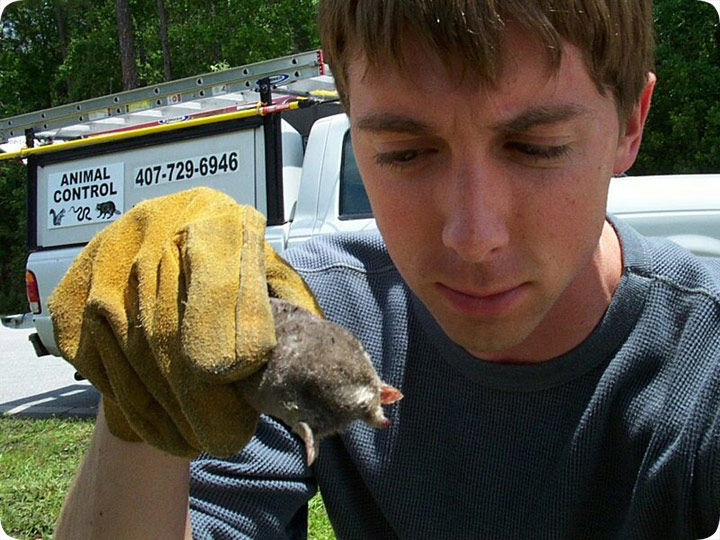-
info@aaanimalcontrol.com
Call us for help in your town
Humane Wildlife Education
Mole Capture & Removal

04.22.2003 - Moles are a common nuisance animal throughout the country. The primary objection that homeowners have to this little creature is that they make a mess of lawns. They live underground, where they are extremely active, tunneling through soil and eating
about half their body weight each day in earthworms and grubs and such. They dig deep tunnels, which aren't noticed, but they also dig surface tunnels for both feeding and movement, and these tunnels create ridges all over a lawn. In addition, moles often dig deep chambers
in which to live or nest, and they often push mounds of dirt up and out of the ground. If a homeowner is concerned about nice
landscaping and a neat lawn, and many people are, they do not care for moles making a mess of the place. Granted, some of these people make mountains out of molehills, but in some other cases, moles can really cause a lot of lawn damage, and thus customers request that I trap
and remove moles.
Mole trapping can be tricky. First of all, there's no live trap for moles. You can't just set a cage and bait it like you can for other animals. Moles live underground, and the only traps that catch them are lethal traps, such as the spear trap or the scissors trap. There's
also no effective mole poison, because moles only eat live earthworms and invertebrates, and they don't eat seeds or nuts or any inanimate food that one could poison. Finally, there's no effective mole repellent. Some people try spraying the lawn with castor oil, and I've
even tried this myself, but it doesn't work. Only physical mole capture will actually do the trick and get rid of the mole problem for good.
In the above photo I'm seen holding an Eastern Mole, which I caught at a customer's house. You can see the phone number on my truck behind me. Call this number if you want moles trapped in Orlando Florida.
Do it yourself: Visit my How To Get Rid of Moles page for tips and advice.
Get professional help: Visit my Nationwide Pro Directory of wildlife removal experts.
For more wildlife stories, click my Wildlife Blog
or click my below banner to hire a local trapper.
They're tiny and can be weirdly cute to some but, these little animals are agents of destruction! They're responsible for ruining beautifully landscaped public parks and private yards.
According to some studies, moles are to blame for soil malnutrition because they tend to eat worms and larvae that are responsible for keeping the land fertilized.
Moles are great at digging and creating tunnels which makes them one of the most difficult to get rid of! They're rarely seen outside their tunnels because of their solitary nature. The tunnels provide them both shelter and a strategic escape route.
They're a special kind of pest and can be hard to deal with. Fortunately, there are multiple ways to capture these little animals.
Here are 5 ways to remove and capture moles on your property:
#1 Place a trap
The first thing you need to do is find the molehill. An indicator of a molehill is the soil is much softer when you step or touch it. After you found the molehill, determine if it's active by stepping into it and check if the soil has been dug up.
Open a portion of the tunnel by using a gardening tool then place the trap of your choice. Cover the trap with a bucket then regularly check it if you've caught the mole. Properly dispose of the body by placing the mole inside a garbage bag
#2 Flood the tunnels
This is a simple and effective way to remove moles from your yard! All you have to do is place the tip of your hose to the molehill then turn on the water. Make sure that you fill-up the tunnel gradually then wait for the mole to surface. After the mole has surfaced, grab it quickly then place the mole inside a bucket.
#3 Bucket trap
After locating the molehill, dig deep through the portion of the tunnel that's exactly the size of your bucket. Pack soil around your bucket then put soil on the openings to trick the mole to dig through it. Then lastly, cover the hole with plyboard or a wooden board to cover the sunlight then wait for the mole to fall in the bucket.
#4 Dig up the mole
This method will put your reflexes to the test so be prepared! Before digging up the molehill, make sure to wear gloves. The first thing you will do is to find a fresh molehill, they tend to dig during the early morning and evening.
Slowly approach the mound and if you see the molehill moving, quickly dig up the mound for about 20 centimeters deep. Don't let the mole burrow back to its tunnel and immediately grab the mole then put it inside the bucket.
#5 Poison their tunnel network
Make sure to wear protective gloves before doing this method. Place pieces of dry ice in multiple holes then add water to activate its poisonous property. Seal up all the tunnels to prevent the mole from escaping.




















